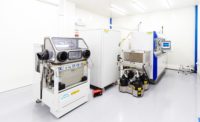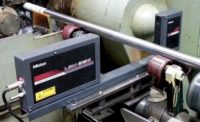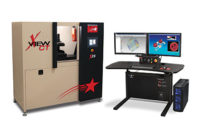3-D imaging is integral to machine vision, dating back to 1960 when Larry Roberts wrote his PhD thesis at MIT on the possibility of extracting 3-D geometric information from the standard 2-D views. Over 50 years later, the field that Roberts helped to build has evolved leaps and bounds in speed, accuracy, and 3-D imaging resolution.
For more insight into the industry’s progression since 3-D imaging was first developed and implemented, Qualityspoke with Martin Hund, CEO of Chromasens GmbH, and Donal Waide, director of sales and marketing for BitFlow, about the state of 3-D imaging today, and also what their companies are doing to push the technology forward.
Could you tell us a bit about the history of 3-D imaging in machine vision and how you have seen the technology evolve into present day?
Martin Hund, Chromasens:Stereo is the technology used in recent years in the machine vision industry. The approach is attractive due to its unique advantages.
For Chromasens, a specialist in color imaging, illumination, and camera technology, the first major step in 3-D imaging was the development of a true RGB stereo camera based on line scan technology. The unique advantage of speed using line scan cameras was topped with fast stereo algorithms running in real time on GPUs at 21 kHz line frequency. This gave Chromasens a big advantage in terms of scanning throughput.
The first cameras developed were 3DPIXA compact cameras in smaller housing; the portfolio was later expanded to dual cameras based on double sensors in order to achieve larger scanning widths. Unique, high-power, and efficient lighting – Corona II was developed further to suit different types of applications.
The outstanding feature of the Chromasens stereo systems is high-quality and high-resolution 2-D, color, and 3-D imaging simultaneously from one camera.
Donal Waide, BitFlow:As people know it, 3-D imaging isn’t limited to the big screen; it has become an effective tool in industrial processes. Examples would be assembly line inspection, product orientation by a machine (robot), and even for measuring in a dimension that before was not an option.
The frame grabbers produced by BitFlow include boards that are capable of taking images from two or more different cameras and sending them to memory for processing as a 3-D image.
What do you see as the biggest current trends, innovations, and advancements in the field?
Hund:In particular for stereo, I expect innovative algorithms taking advantage of a combined 2-D and 3-D image analysis using the specific advantage of the stereo approach. These new algorithms will have advantages for several applications and will increase the number of stereo systems used in machine vision.
Newer and faster hardware will make stereo in high-speed available at lower costs. Higher speed and lower cost in combination with specific stereo algorithms will result in a growing number of applications for the stereo approach.
Waide:With machine vision, customers are demanding more data for inspection. This means larger sensors enabling the companies to employ cameras that achieve higher resolution, faster frame rates, and as a result, better solutions.
For 3-D the path is the same; just as machine vision is no longer limited to portions of industry, the advancement of 3-D in all areas of industry is a technological reality. In areas where it is unsafe for humans to operate effectively, such as with hazardous substances or in dangerous locations, a 3-D system would be an ideal solution.
How are your company’s products transforming the industries they support, specifically in the realm of 3-D imaging?
Hund:We see several customers switching from 2-D to 3-D inspection using our stereo approach. This step could change a lot at the customer side, since a better process control is possible with the additional 3-D information. This requires new and improved process control at the customer side, and in the end, leads to a higher product quality.
Waide: The CoaXPress standard is currently capable of up to 2.5GB/S. In the next few years, this will increase to double this speed. Also, the current distance of cable capable of carrying these speeds is ~67M. This will open up new areas of industry which were limited by distances (Camera Link) or by data rates (GigE Vision, USB3).
In terms of 3-D imaging, the volume of data as well as the capable distances will enable companies to perform tasks that were once a pipe dream.
What excites you most about your company’s imaging technology? What do you find most challenging?
Hund:Most exciting are the many new 3-D applications coming up with the line scan stereo approach, which is still rather new in machine vision. The unique features of this approach enable applications which cannot be solved with other 3-D technologies.
The challenge is to provide the whole solution for this large variety of applications. This is only possible in close cooperation with our partners. Combining our outstanding 3-D line scan imaging with the unique 3-D image processing from our partners results in solutions that are optimized for the customers’ applications.
Waide:BitFlow has constantly worked on being one of the fastest image acquisition frame grabbers in the market. Using our current StreamSync technology, our DMA algorithms are smoother than ever, enabling us to achieve data rates which are fully capable of the current fastest interfaces.
With CoaXPress (4 links at 6.25 Gb/S) BitFlow has worked with NVidia to develop a GPU Direct technology capable of keeping up with the current data rates. Currently, we are one of the only frame grabber manufacturers capable of offering this option. As customers require more and more data to process, it’s a trend that’s becoming more and more popular.
Machine vision has come a long way from inspection on the alignment of a label on a bottle. It’s now involved in almost every industry on the planet, from semiconductors to life sciences to computer technology. In time, we will wonder what we ever did without it.





